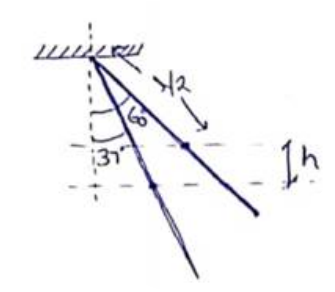A uniform rod pivoted at its upper end hangs vertically. It is displaced through an angle of $60^{\circ}$ and then released. Find the magnitude of the force acting on a particle of mass $\mathrm{dm}$ at the tip of the rod when the rod makes an angle of $37^{\circ}$ with the vertical.

By energy conservation
$\frac{1}{2} I \omega^{2}=m g h$
$\frac{1}{2}\left(\frac{m L^{2}}{3}\right) \omega^{2}=m g \frac{l}{2}\left(\cos 37^{\circ}-\cos 60^{\circ}\right)$
$\omega^{2}=\frac{9 g}{10 I}$
So, centrifugal force
$F_{C}=(d m) l \omega^{2}$
$F_{C}=0.9 g(d m)$
Let angular acceleration of the rod be $\alpha$ when it makes an angle of $37^{\circ}$ with the vertical. $\mathrm{T}=\mid \alpha$
$\operatorname{mg}\left(\frac{l}{2} \sin 37^{2}\right)=\left(\frac{m L^{2}}{3} \alpha\right)$
$\alpha=0.9\left(\frac{g}{q}\right)$.
So, tangential force
$F_{t}=(d m)\left(a_{t}\right)$
$=(d m)(l \alpha)$
$F_{t}=0.9 g(d m)$
So,
$F_{N}=\sqrt{F_{t}^{2}+F_{C}^{2}}$
$F_{N}=0.9 \sqrt{2 g}(d m)$
Click here to get exam-ready with eSaral
For making your preparation journey smoother of JEE, NEET and Class 8 to 10, grab our app now.
